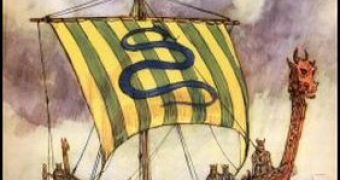At the end of the 8th century, a group of enigmatic people emerged in Europe. These tall and blond Norsemen (literally "people of the north"), or Vikings (vik in Norwegian means gulf or fjord), as they are more commonly known, started an era of over two centuries of plunder, terror, exploration, trade and conquest in Northern Atlantic and Europe till the Middle East, to Baghdad and Caspian Sea.
They colonized one millennia ago Greenland and Iceland and were the first Europeans to step on American ground, five centuries before Columbus, on the shores of Quebec. Life in Scandinavia was harsh, not very favorable to agriculture and animal husbandry. That's why Vikings preferred to dominate the sea. The coniferous forests delivered a lot of good wood for making ships. Vikings were good traders and had a great role in the economic development of cities like Nottingham, Rouen, Kiev and others.
All their achievements would have not been possible without their ships, of perfect design, and their sailing skills. Their ships, called drakkars, were a technological breakthrough at the time. The Vikings made ships able to navigate in any condition. They were 24-28 m (80-83 ft) long, 3.5-5 m (12-17 ft) wide, and 2 m (7 ft) tall. Being long, these ships were swift and could transport large amounts of goods.
Using 1-2 sails (masts), these solid ships were able to cross without any difficulty hundreds of miles in the open sea; by paddling, these relatively small boats of shallow draft were ideal for navigating on the rivers, and they could have been also dragged on ground over short distances.
The paddling men had wooden seats on the edges of the ship; about 16 pairs of paddles were used. Thus, these ships were adequate for both attacks and explorations. In a typical attack, the Vikings employed 2-3 ships, each carrying 40-50 men, armed with swords, bows, spears and axes, and protected by helmets, wooden shields (covered with cow leather) and iron mails.
There is a common goof, depicting Vikings with horned helmet. That's false! Their helmets were simple; the horned helmets were typical for some Celtic tribes.
The Vikings did not know the compass nor the sextant, but they guided themselves using the sol, the stars and the sea birds flight.
Recently, the Vikings were proven to have even employed sunstone crystals to sail in foggy conditions. (That's why their attacks many times took their targets by surprise). The Vikings preferred to employ oak wood to make their ships, because the natural curving of the branches eased the creation of aerodynamic shapes. To build the ship, the wooden planks were mounted one over each other and were secured with iron rivets. A wool rope was sunk in tar and put under pressure between the planks to impede water to penetrate.
The woolen sails were made from the wool of an ancient type of northern sheep, with a thicker hair, which made the weave stronger and lighter, but also water resistant. The rotating sail and the mobile rudder, mounted on the extreme rear part of the ship, enabled attacks and escape at maximum speed, no matter the wind direction. The rigs were made from horse hair. The prow always bore a curved figure, usually a dragon head.

 14 DAY TRIAL //
14 DAY TRIAL //